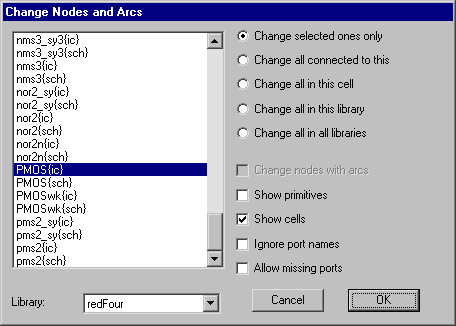6-6: Replacing Circuitry |
6-6: Replacing Circuitry |

When replacing an arc, the existing nodes on either end must be able to reconnect to the new type of arc. If "Change nodes with arcs" is checked, nodes will be changed to allow the new type of arc to remain connected.
When replacing a node, the existing arcs on it must be able to reconnect properly to the new node. However, the sizes of the replaced object can be different, and the layout will be adjusted. Electric determines which ports on the replaced node to use by examining the port names and locations. If the ports are aligned correctly but not named the same, this matching will fail. Check "Ignore port names" to disable name matching and use only position information. If the new node is missing essential ports, such that existing wires cannot be reconnected, then the change will fail (unless "Allow missing ports" is checked).
Besides replacing the currently highlighted node or arc ("Change selected ones only"), it is also possible to specify replacement of many other objects.
Some Schematic nodes use parameters to further describe them. For example, an Electrolytic Capacitor is really just a Capacitor with the "electrolytic" parameter on it. Therefore, you can change a node into a Capacitor, but not an Electrolytic Capacitor, because it is not in the list. However, once changed, you can use the Get Info command of the Info menu to set the parameter and turn it into an Electrolytic Capacitor. Besides Capacitors, parameters can be found on Diodes, Transistors, Sources, and Two-Ports (the four-connection primitives such as VCCS).
Because arcs can connect only to certain types of nodes, it can be difficult to replace both. For example, if you wish to convert all Metal-1 into Metal-2, then you must replace all Metal-1 arcs with Metal-2 arcs, and you must replace all Metal-1-Pins with Metal-2-Pins. It is not possible to do this all at once, nor is it possible to do it in any two-step fashion (you cannot replace the arcs, because the pins won't connect to the new type, and you cannot replace the pins, because the arcs won't connect to the new type).
The solution is to use the Universal arc and the Universal Pin (from the Generic technology, see Section 7-9). These components can connect to any other, and so they can be used as intermediate placeholders. The solution to converting Metal-1 into Metal-2 is as follows:
| Previous | Table of Contents | Next |